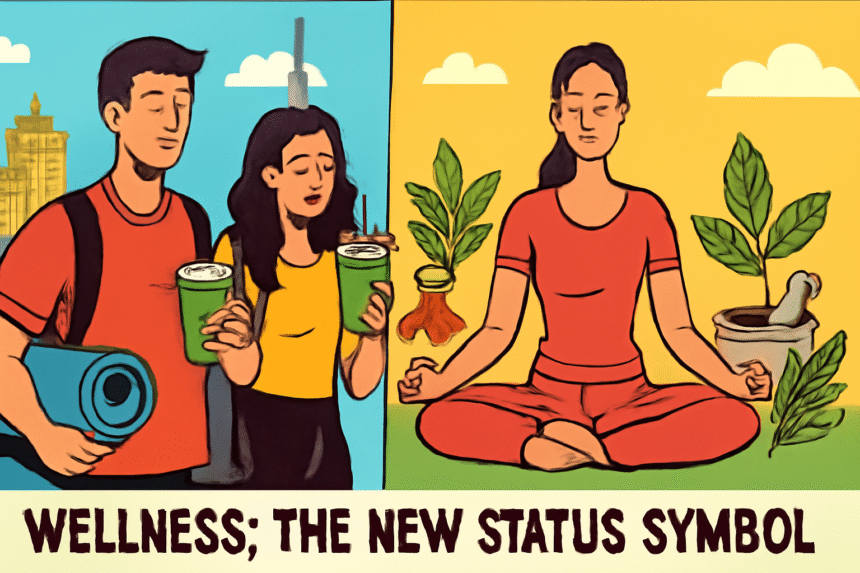Matcha lattes, smartwatch metrics, and chlorophyll shots are the new badges of ambition for India’s under-35s. But can conspicuous health spending solve a looming obesity crisis—or is it just the latest status game?
Within the glass-walled cafés of Gurugram and the neon gyms of Bengaluru, a silent currency is trading hands—one measured in chlorophyll shots, smartwatch metrics, and #NoDaysOff selfies. What began as a reaction to startling lifestyle-disease statistics has morphed into a full-blown social signal: in 2025, wellness is India’s fastest-rising marker of ambition, belonging, and power.
India’s Wellness Boom—Powered by Anxiety
- The domestic health-and-wellness market is sprinting toward ₹6 trillion ($72 billion) by year-end at a 28% CAGR.
- A single category—matcha-based drinks—grew to ₹870 crore in sales and is forecast to touch ₹1,400 crore by 2030.
- Corporate India now spends ₹639 crore on employee-wellness programmes, projecting ₹809 crore by 2030 as stress management becomes the hottest HR line-item.
Kantar’s 2025 foresight study concludes that young consumers “treat the body like a connected device to be constantly optimised,” a trend it labels science-framed self-care.
Yet the same demographic faces the world’s third-highest obesity burden. Nearly one in four Indian adults is now overweight, and a Lancet model warns that one-third of the population could be clinically obese by 2050. Cardiologists already report heart-attack patients in their thirties, a full decade earlier than in 2005.
How We Got Here: From Obligation to Aspiration
Until recently, “being healthy” in India meant not falling ill. Covid-19, social media, and rising disposable incomes rewired that mindset. Today’s 16- to 35-year-olds equate wellness with productivity, social cachet, and even romantic capital. An NIQ survey found 42% of urban Indians willing to pay a premium for functional foods if they promise stress relief or gut balance.
Dr. Sneha Iyer, a Mumbai endocrinologist, notes a “treadmill of performative health”: “Patients arrive with app screenshots of their sleep cycles and cortisol scores, yet skip basic check-ups. They want metrics, not medicine.”
The Global Mirror: YOLO Wellness in the West
America and Britain underscore both opportunity and caution.
- United States
- United Kingdom
Global consultancy Precedence Research calls this “conspicuous health consumption,” predicting the wellness economy will exceed $11 trillion worldwide by 2034, fuelled chiefly by urban under-forties in India, China, the U.S. and the U.K..
The takeaway? High-visibility habits don’t automatically produce better biomarkers—an insight India can leverage before repeating Western mistakes.
Myth-Busting the Expensive Shortcut
Wellness for Every Wallet
India’s boom need not be an elite sport. Four evidence-based, affordable moves beat any ₹350 latte:
- Daily 30-minute walk: Improves insulin sensitivity and mood—zero cost.
- Home-cooked lentils & vegetables: Delivers fibre and protein for under ₹60 per meal.
- Digital-sunset rule: Logging off screens one hour before bedtime boosts REM sleep without pricey melatonin gummies.
- Government-subsidised yoga centres: AYUSH ministry classes often charge under ₹500 per month, marrying tradition and science.
Tech and Tradition: The Hybrid Opportunity
Wearables: India imported 10 million smartwatches last quarter, with 70% of buyers under 35.
Ayurgenomics: Bengaluru start-ups now offer DNA-based dosha analysis, merging genomics with Ayurveda for personalised diet plans.
Tele-wellness: Post-pandemic, only 11% of Indians trust digital healthcare apps, signalling a vast but fragile frontier.
Companies that balance evidence with cultural resonance—think AI-powered nutrition advice paired with millets and ghee—stand to dominate the next decade.
Turning Status Into Substance
India’s wellness wave can become more than conspicuous consumption if five stakeholders act:
- Consumers: Shift focus from Instagram-ready “clean eats” to long-term metrics: resting heart rate, waist-to-height ratio, mental-health days.
- Brands: Provide transparency on clinical backing; stop conflating “natural” with “better.”
- Employers: Measure programme ROI not by participation selfies but by absentee rates and insurance claims.
- Policymakers: Expand FSSAI nutrition labels to include added-sugar traffic-lights on packaged drinks.
- Healthcare Providers: Bridge app data with medical records so self-tracking informs, rather than replaces, professional care.
Final Sip
Your matcha latte can still be a morning ritual; just don’t confuse its green hue with guaranteed health. At ₹350 a cup, it is less an elixir than a lifestyle statement. Real wellbeing rarely photographs well—it shows up in blood panels, quiet stamina, and the calm that follows eight hours of offline sleep.
India has the advantage of hindsight. The West taught us that a trillion-dollar wellness spree can coexist with record obesity. The challenge—and opportunity—is to turn healthism from a badge into a baseline, ensuring that the next status symbol is not what you drink, but how sustainably you live.







